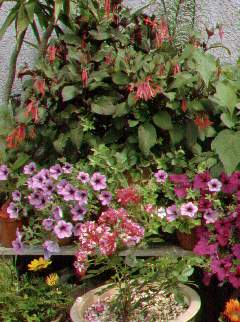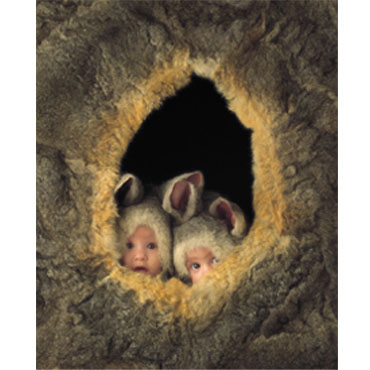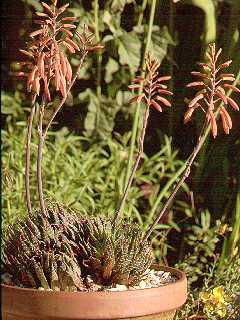|

Even the smallest patio or porch can boast a crop of vegetables or a garden of flowers in containers. Planter boxes, wooden barrels, hanging baskets and large flowerpots are just some of the containers that can be used. The container gardener is limited only by his imagination. Consider the following guidelines when choosing your container.
Avoid containers with narrow openings.
Cheap plastic pots may deteriorate in UV sunlight and terracotta pots dry out rapidly. Glazed ceramic pots are excellent choices but require several drainage holes.
Wooden containers are susceptible to rot. Redwood and cedar are relatively rot resistant and can be used without staining or painting. Avoid wood treated with creosote, penta or other toxic compounds since the vapors can damage the plants. One advantage of wooden containers is that they can be built to sizes and shapes that suit the location.
Use containers between 15 and 120 quarts capacity. Small pots restrict the root area and dry out very quickly. The size and number of plants to be grown will determine the size of the container used. Deep rooted vegetables require deep pots.
Make sure your pot has adequate drainage. Holes should be 1/2 inch across. Line the base of the pot with newspaper to prevent soil loss.
In hot climates use light-colored containers to lessen heat absorption and discourage uneven root growth.
Set containers on bricks or blocks to allow free drainage.
Line hanging baskets with sphagnum moss for water retention. Keep baskets away from afternoon sun.
If you choose clay pots, remember that clay is porous and water is lost from the sides of the container. Plants in clay pots should be monitored closely for loss of moisture.
Growing Mixture
Make sure your planting medium drains rapidly but retains enough moisture to keep the roots evenly moist. Your compost will make an excellent potting soil. Check the requirements of the plants you grow to determine whether you will need to add sand. If compost is not available, purchase a good quality potting mixture or make your own from equal parts of sand, loamy garden soil, and peat moss. Commercial potting mixes are usually slightly acidic, so you may want to add a little lime.
Most container gardeners have found that a "soilless" potting mix works best. In addition to draining quickly, "soilless" mixes are lightweight and free from soil- borne diseases and weed seeds. These mixes can be purchased from garden centers.
When you add your soil to your container, leave a 2 inch space between the top of the soil and the top of the container. You will be able to add 1/2 inch or so of mulch later.
Sunlight
Your container garden will need at least five hours of direct sunlight each day, and many plants will benefit from even more. As a general rule, leafy vegetables such as cabbage and lettuce can tolerate the most shade, while root crops such as beets and carrots will need more sun. Fruiting vegetables such as tomatoes and cucumbers need the most sun. The amount of sunlight needed by flowers varies depending on the varieties grown. Check the flower guides for sunlight requirements.
Fertilizer
Since potting mixes drain water rapidly, fertilizer will be washed out of the container as you water. Lighter mixes will require more frequent fertilizing than heavier mixes. It's a good idea to use a dilute liquid fertilizer with every other watering. Liquid fish emulsion or liquid seaweed are great plant boosters, but remember that you need to provide your plants with a variety of nutrients. Check the labels on the products in you garden center to be sure that they contain a complete, balanced solution that includes trace elements.
Watering
In an exposed location, container plants loose moisture quickly. Some plants will need to be watered daily, especially during hot, dry weather.
What to Grow?
Annuals
Annuals suitable for containers include:
Alyssum -- Carpet of Snow, Royal Carpet, Rosie O'Day
Begonia (Wax) -- Glamour, White Christmas, Othello
Browallia -- Blue Bells
Coleus -- Red Monarch, Fashion Parade, Magic Lace
Cuphea -- Firefly
Geraniums -- Most varieties
Impatiens -- Tangeglow, Elfin Hybrids, Imp Hybrids, Blitz
Latana -- Yellow Compacta, White Compacta
Lobelia -- Blue Cascade, Sapphire
Marigolds -- Dwarf French, Panther, Queen Sophia, Boy Series
Periwinkle (Vinca rosea) -- Little Bright Eyes, Little Blanche, Little Pinkie
Nasturtiums -- Gleam Series
Pansies -- Mammoth Giants
Petunias -- Cascade Hybrids, Comanche, Bernese Hybrids
Salvia -- Carabiniere Hybrids, Saint John's Fire, Victoria
Sanvitalia -- Gold Braid
Snapdragons -- Floral Carpet
Thunbergia -- Susie Mix
Torenia -- Mixed colors
Verbena -- Amethyst, Blaze, Sparkle Mixed Colors
Zinnias -- Button Series, Chippendale |
 |
|
 |
|
|
|  |
|
|
 |
|

Small salad green such as oak leaf lettuce and mustard cress, or vegetables such as silver beet, which have a quick maturing period are ideal.
You may be able to get several crops of a quick maturing vegetable from your container. Cherry tomatoes and other fruiting vegetables, including peppers or eggplant can be easily grown in containers, as can root vegetables such as baby carrots, radishes or spring onions. Try planting quick-growing small herbs and leaf lettuces around you larger fruiting vegetables.
For an indoor garden to flourish, attention must be paid to
the basic growing requirements. When planting, use potting
soil. Outdoor garden soil compacts easily, thus inhibiting
root growth. A good general soil can be made by mixing 1/3
vermiculite or peat, 1/3 perlite, and 1/3 commercial potting soil. Gravel can be placed in the bottom, but it is NOT a substitute for drainage holes.
Indoor plants should receive more nutrients and water than
their outdoor counterparts. In the confinement of a
container, competition is fierce. Fertilize every two weeks
with a balanced (all numbers are equal) houseplant
fertilizer. Do not let the soil become overly dry; daily
watering may be required by the time plants reach
productivity.
Light is critical to growth. A south-facing window is best.
Fruiting plants in particular require at least twelve hours
of bright light, which may be difficult to obtain in
Michigan winters. Annuals are more specific in their light
requirements. Although most do best in a south window it
is the daylength that is critical (Photoperiodism). Short
day plants flower when there is only 10 to 12 hours of
light and will not flower with excess light. Long day
plants require at least 14, and preferably 18, hours of
light to flower. These plants are best grown under a
fluorescent light. Indeterminate plants have minimal
photoperiodic response. This category includes most
vegetables.
Most leafy and root crop vegetables prosper in cool
temperatures. Highs of 60 to 65 degrees Fahrenheit with
lows at night ranging all the way down to 40 degrees
Fahrenheit are acceptable. Fruiting vegetables and most
annuals require warm temperatures. For example, tomatoes
will not set fruit unless nighttime temperatures are between 60 and 70 degrees Fahrenheit, with ideal daytime
temperatures at about 80.
Containers used for indoor gardening must provide
drainage and adequate room. Follow the planting directions
in seed catalogs or on seed packets to calculate the number
of plants per container.
Recommended containers vary, providing a number of aesthetically pleasing options. Some suggestions are: pots, wastebaskets, buckets, aquariums,waterproof bushel baskets, crates with black plastic with a few holes for drainage, a hollowed-out log for flowers, and washtubs. One unusual example of an indoor container is a 24-inch washtub with holes punched in the bottom for drainage. This container will hold: 25 bean, beet, spinach, leaf lettuce, or turnip plants, 18 endive or Swiss chard plants, 50 dwarf carrots, radishes, or bunching onions, 12-18 small to medium size annual flowers, and one cucumber,tomato, or squash. 
|
 |
|
|
